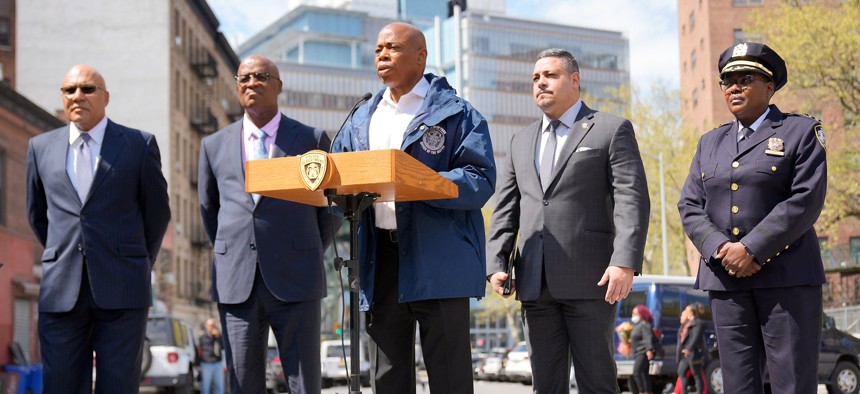Higher than expected tax revenue? Reversed agency budget cuts? We’ve been here before.
New York City Mayor Eric Adams unveiled a $111.6 billion budget proposal Wednesday that restores some previously slashed funding – buoyed in large part by better than expected revenue projections and a swell of savings on migrant services – but stops short of restoring all of the agency cuts instituted by the administration so far.
The executive budget proposal for fiscal year 2025 is up about $2.2 billion from the $109.4 billion preliminary plan released by Adams in January and clocks in around $4 billion more than this current fiscal year’s adopted budget.
Adams touted the sunnier outlook and partially restored funding as a measure of his administration’s strong fiscal management. “As soon as we saw the hurdles ahead, we responded swiftly, strategically, with a healthy dose of caution,” Adams said, adding that the balanced budget was achieved without layoffs or tax increases. “We made smart choices, trimmed agency and asylum-seeker budgets and made conservative revenue forecasts. This, combined with better than expected revenues and a booming economy, resulted in a balanced budget.”
After announcing last fall that the city would implement three rounds of 5% cuts across city agencies to close ballooning budget gaps blamed largely on spending for asylum-seeker services, City Hall has gradually walked back from some of those cuts. As the city has released higher tax revenue projections and announced plans to cut down on spending on the some 190,000 migrants who have arrived in the city since last spring, it has also reversed some cuts to specific agencies announced in previous plans and fully canceled the planned 5% cut across agencies that was set to be included in this budget plan.
The mayor’s proposed budget restores funding for cultural institutions and for two previously cut New York City Police Department classes, which will increase the number of cops in the city, It also pledges funding towards a number of public school programs like the expansion of free preschool for 3-year-olds and school-based mental health professionals that were previously funded by temporary stimulus dollars slated to expire this school year. But the executive budget didn’t restore all of the administration’s previous cuts to agencies; most notably, a cut to the city’s library systems remains.
Some lawmakers and advocates have criticized City Hall for underestimating revenue, leading to unnecessary cuts. Earlier this month, the City Council identified $3.3 billion in unrealized tax revenue that wasn’t included in Adams preliminary budget plan. Budget watchdogs, too, have questioned the city’s estimates. “While conservative revenue projections are routine, the city’s practice of implementing preemptive cuts can weaken its ability to deliver core services, hastening population loss and undermining New York's long-term economic health,” Fiscal Policy Institute Director Nathan Gusdorf said in a statement on Wednesday.
The Citizens Budget Commission also charged that low-balled expenditures have clouded the city’s fiscal picture. “New York City’s Fiscal Year 2025 executive budget significantly under budgets for planned services, leaving New Yorkers without a clear view of the city’s fiscal picture or how it will maintain, expand, or shrink critical programs, given looming gaps,” Citizens Budget Commission President Andrew Rein said in a statement. “Only real, reasonable estimates will drive smart choices on spending and service priorities.”
Still, Adams stood by the city’s decision to institute multiple rounds of cuts, which are also known as “Programs to Eliminate the Gap,” or PEGs. “If we didn't start early with our PEGs, we would have a challenging time,” he said in a Q&A with reporters on Wednesday afternoon. The mayor specifically pointed to the $7 billion budget gap that the city projected in November for the next fiscal year and which the city later said it had closed in the January preliminary budget.
The release of the mayor’s executive budget is a procedural step in the budget process in which the administration typically revises revenue projections and total spending. But it’s also a chance for the mayor to drive home arguments for his administration’s achievements. Adams didn’t waste that opportunity on Wednesday, highlighting his “jobs up, crime down” refrain, major City of Yes zoning updates and even the administration’s recent victories in the state budget.
The budget dance is far from over. The City Council will now hold a second round of hearings on the administration’s proposals and will likely continue to advocate for funding restorations, which may or may not be included in the final adopted budget. The final agreement is due June 30, a day before the new fiscal year begins July 1.
New York City Council Member Justin Brannan, chair of the council’s finance committee, said the mayor’s executive budget leaves more than $1 billion on the table. He said that the budget does not go far enough in funding vital programs like pre-K and 3-K outreach to fill vacant seats, libraries, programs to reduce recidivism, cultural institutions and other City Council budget priorities.
“We didn’t see any restoration of the library cuts. This further throws New Yorkers into chaos. A lot of these cuts – we talk to people all the time. They don’t know when the cuts are actually made, how the cuts are proposed, and that just adds to a type of feeling in the city that you don’t want,” he said, speaking to reporters after the mayor’s budget announcement.
Brannan said he hopes the mayor is leaving some room for negotiation, but the council’s priorities are clear and are not going to change during negotiations.
“It’s important to remember that a lot of our restorations just get us back to zero,” he said.
NEXT STORY: The biggest issues left out of the state budget


